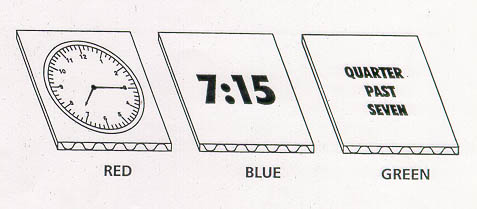
A D I V I S I O N O F E K L A V Y A E D U C A T I O N F O U N D A T I O N
|
Code : TLM-M-006 |
|
Name: Read The Clock |
|
Read the Clock (Click to view Video) This
game helps children to read the time by looking at the position of hour hand
(smaller hand) and minute hand (bigger hand). They link the hands of the clock
with the number on the clock face and read the time. It also helps them to
tell the time in words and figure. 
Each set
contains
|
| How to use |
| Step 1: The student is asked to separate the 66 cards into 3 piles, colour wise (Yellow – Purple – Green). The student, spreads out the 22 yellow cards on the table, she then takes the time in words card (green) and matches on a one-to-one basis with the yellow cards. Please note that this should be done one card at a time, that is, one green card is taken, the student searches amongst the yellow cards to find its partner, and having found it places it below the card. If she does not find the partner card, she should be encouraged to try more (and discouraged from putting that green card on the side and going ahead with the next green card). |
| Step 2: After the green pile has been matched with the yellow, the student picks up the time pile (purple) and continues the matching. The game is over when all 22 sets are matched. |
| There is no concept of time limit for this game as the purpose is to induce the student into a mood of reflective thinking. At the end of the game if the educator spends some time with them communicating the concept of time and it gets nicely imprinted in their mind. |
| Development aspects |
| Time is quantitatively expressed in hours, minutes and seconds. Clock is a common equipment used to indicate time. This game is based on the concept of clock and introduces the child to read the clock. |
|
Principle |
|
|
|
|
|